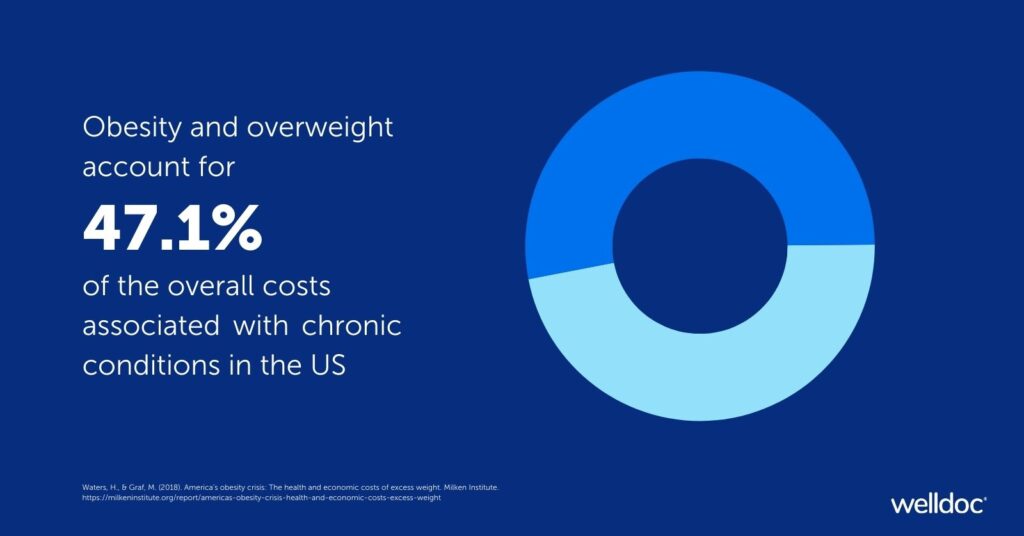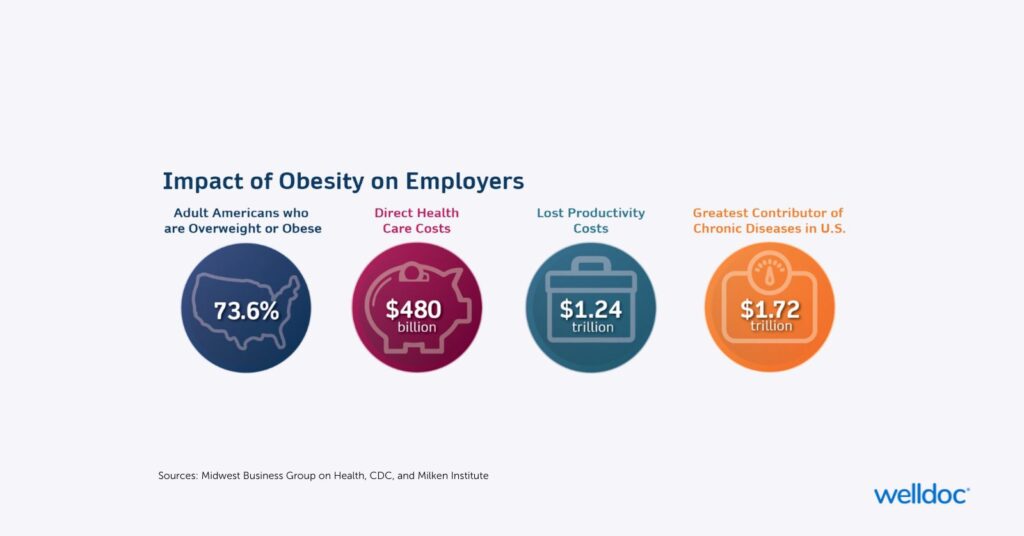The growing prevalence of obesity in the United States, reaching nearly 42% of adults¹, has significant health and economic ramifications. This issue extends beyond individual well-being, impacting employers through rising healthcare costs, productivity losses, and absenteeism. The repercussions of obesity also reverberate across other sectors, affecting healthcare expenditures and the overall economic well-being of the nation.
The Employer Challenge and Opportunity
Employers face growing financial strain due to rising healthcare costs, with chronic conditions as a key driver. A recent pulse survey projects a 7% median increase in healthcare costs for 2024, with 22% attributed to the escalating prevalence of chronic conditions². This translates not only into a growing burden on employee well-being but a significant financial challenge for businesses.
One factor fueling this cost increase is the rising reliance on semaglutide, including Ozempic (a GLP-1 with an average monthly cost of around $1,000 per patient³). Although these medications are valuable for managing obesity and its associated health risks, their rising demand, fueled by the increasing prevalence of such conditions, results in a significant new expense for employers. Coupled with the rising burden of other chronic conditions, such as diabetes and heart disease, this presents a complex and concerning scenario for employers.
Other factors contributing to cost increases extend beyond direct medical expenses for obesity-related conditions like diabetes and heart disease and encompass a range of indirect costs for employers. These include lost productivity due to:
- Absenteeism: Employees living with obesity miss an average of 4.3 more workdays per year due to illness, resulting in a national productivity loss of $260 billion annually.5
- Presenteeism: Obesity is associated with reduced on-the-job productivity due to health issues, impacting both employee performance6 and business costs.
Despite these challenges, ample room for optimism remains. Recognizing the complexity of this issue, forward-thinking businesses are taking proactive steps to address it. Investing in preventive measures such as holistic digital health initiatives can empower employees to reach and maintain a healthy weight.
Beyond Medications: Exploring New Solutions
The effectiveness of digital health solutions in managing weight and chronic conditions is well documented. Studies show that even a modest 5% weight reduction in individuals with obesity can significantly reduce annual medical expenses7. This highlights the potential of these solutions in addressing multiple health concerns through a single platform, offering several key advantages:
- Cost-effective: Compared with expensive medications, digital solutions provide a more affordable approach, making them a financially viable option for employers seeking to reduce the financial burden of obesity-related health issues.
- Holistic support: Beyond weight loss, these platforms offer comprehensive support for individuals managing chronic conditions and provide guidance for those using medications, addressing the multifaceted nature of obesity-related health challenges.
- Personalized guidance: Digital platforms leverage data and AI to personalize the weight management journey for everyone, providing tailored insights, setting achievable goals, and tracking progress. This personalized approach fosters engagement and increases the likelihood of long-term success.
- Sustainable success: The focus on building healthy habits, rather than quick fixes, enables individuals to make lasting lifestyle changes that contribute to sustainable weight management and improved health outcomes, ultimately benefiting both the individual and the employer.
The Welldoc platform supports the entire weight loss journey and helps individuals reach and maintain a healthier weight. Through its digital offering, employees are empowered to build and sustain health habits for long-term weight loss.
By investing in innovative solutions and prioritizing preventive measures, employers can play a crucial role in mitigating the impact of obesity, not only to their bottom line but also on the health and well-being of their employees and the broader healthcare ecosystem.
Ready to transform your approach to employee health? Contact us to explore how our tailored platform can support your employees’ entire weight loss journey.
References:
- Centers for Disease Control and Prevention. (2022, May 17). Adult obesity facts. Centers for Disease Control and Prevention. https://www.cdc.gov/obesity/data/adult.html
- Waters, H., & Graf, M. (2018). America’s obesity crisis: The health and economic costs of excess weight. Milken Institute. https://milkeninstitute.org/report/americas-obesity-crisis-health-and-economic-costs-excess-weight
- International Foundation of Employee Benefit Plans. (2023). Health Care Costs Pulse Survey: 2024 cost trend. Health Care Costs Report. https://www.ifebp.org/store/Pages/health-care-costs-report-2024.aspx
- Amin, K. A., Telesford, I., Singh, R. S., & Cox, C. C. (2023, August 17). How do prices of drugs for weight loss in the U.S. compare to peer nations’ prices? Peterson-KFF Health System Tracker. https://www.healthsystemtracker.org/brief/prices-of-drugs-for-weight-loss-in-the-us-and-peer-nations/#List%20prices%20of%20drugs%20used%20for%20weight%20loss%20in%20the%20U.S.%20and%20peer%20nations
- Goettler A, Grosse A, Sonntag D. Productivity loss due to overweight and obesity: a systematic review of indirect costs. BMJ Open. 2017 Oct 5;7(10):e014632. doi: 10.1136/bmjopen-2016-014632. PMID: 28982806; PMCID: PMC5640019.
- Kudel, I., Huang, J. C., & Ganguly, R. (2018, January). Impact of obesity on work productivity in different US occupations: Analysis of the National Health and Wellness Survey 2014 to 2015. Journal of occupational and environmental medicine. https://www.ncbi.nlm.nih.gov/pmc/articles/PMC5770108/
- Thorpe K, Toles A, Shah B, Schneider J, Bravata DM. Weight Loss-Associated Decreases in Medical Care Expenditures for Commercially Insured Patients With Chronic Conditions. J Occup Environ Med. 2021 Oct 1;63(10):847-851. doi: 10.1097/JOM.0000000000002296. PMID: 34138824; PMCID: PMC8478295.






